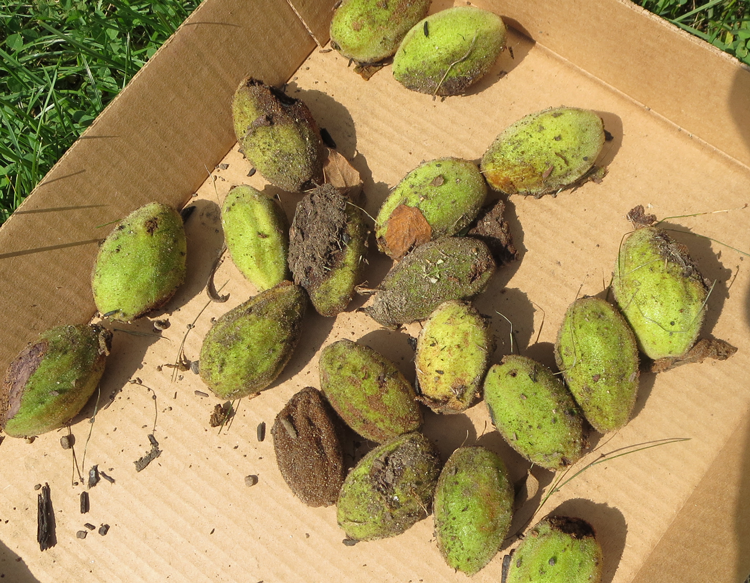Growing Butternut Trees
Although butternut trees have nearly disappeared in New Hampshire, I just found one that is currently loaded with nuts. I had never noticed the nuts on the tree, and am amazed at how many grow in the huge clusters. What potential bounty! No wonder butternut trees were widely planted around early farmhouses – they were both tasty and useful.
Butternut trees were the first tree species I learned to recognize by their bark. Mature trees have thick, deeply furrowed bark that is distinctive. This revelation happened years ago when I was taking the series of classes to become a Tree Steward, now called the Natural Resources Stewards, through UNH Extension and the NH Division of Forests and Lands. Sadly, the Butternut trees that grew in the Pine Island area of Manchester where the course was taught have all died of Butternut Canker Disease, as have many of the old Butternut trees in NH. A fatal fungal disease that arrived in the US in the 60s, it has spread throughout the tree’s range.
After completing the program, I volunteered for the NH Big Tree Program and learned how to measure and track the biggest trees of each species in my county. The discovery of a former county champion butternut tree that had become a dying carcass due to Butternut Canker was sad and shocking. So when I noticed a healthy butternut tree dropping nuts onto a highway near me, I was curious enough to stop and gather up some to see if they would grow. Maybe I would discover a resistant tree! I planted several rows of the oblong nuts in the vegetable garden.
I covered the plot with chicken wire to keep the squirrels from feasting on them. I was thrilled to see sprouts the next spring; healthy stout stems with tiny compound leaves unfurling. Of course I had to get the chicken wire off before the sprouts got tangled up in the wire, and I had to move the plants out of the corn patch so we could plant. I potted them up to give away. Some grew in the pots for a year or two until I could find homes for them.
I kept several and planted three on our property. The one in this photo was transplanted from the pot last summer, 2018, to replace a maple that died of fusarium wilt. I could not plant another maple because the soil was contaminated with wilt disease spores. So with Butternut saplings looking for a sunny site, I planted this tiny crooked tree seedling. It is also near a water faucet.
Deer nibble on anything in their path so I put a tomato cage around it. With generous watering, it doubled in size. The other two, not planted handy to water or my attention, hardly grew and did get nibbled by deer. My tiny tree exploded this rainy summer, and doubled in size again – it is amazing!
Butternut, like black walnut trees, are shade intolerant and grow in full sun. They can grow fast under good conditions. The large compound leaves cast dappled shade and turn yellow in the fall. Like most nut trees, they are deep rooted and not easily transplanted. Early farmers planted the nuts near farmhouses for handy fall harvesting. The oily butternuts were used in baking and candy making, especially maple-butternut candy (original butterfingers) famous in New England. Husks were used to make a soft orange/yellow dye for work clothes, and the wood was used in fine cabinetry and later for veneer.
Butternut trees are smaller than black walnuts and generally shorter lived – 75 years. But they are hardier in cold climates and are found further north in New Hampshire. The long oval-shaped nuts are an easy way to identify the tree – quite different from the round black walnuts. Both nuts have a very hard shell.

Before I planted all the nuts I gathered, it occurred to me that I should taste one, although they aren’t at all appetizing-looking in their dried-up brown husks. I rubbed off the husk and tried cracking the shell with a nutcracker with no success. Hammers make a mess and mush of the nuts, so I tried cracking it in a vise, which worked nicely. The nut was larger than expected and not at all shriveled. No odor, so I bravely tried it and found it tasty. In fact, they taste just like the name: butternut! They were more like an English walnut than the sharp distinctive taste of the black walnut. Obviously this is why butternuts were once were so popular and commonly sold in markets in the fall.
Although Butternut trees are less plentiful due to the canker, they can still be found in NH. Fall is a great time to keep a lookout for the butternuts themselves, give one a try and tell me what you think.
Click here for more information about Butternut trees.
UNH Cooperative Extension Natural Resource Stewards and Big Tree volunteers share information about nature and tree topics with the people of New Hampshire. Got questions? Natural Resource Stewards and Big Tree volunteers work with Master Gardeners to provide practical help finding answers to your questions through the Ask UNH Extension Infoline. Call toll free at 1-877-398-4769, Monday to Friday, 9 a.m. to 2 p.m., or e-mail them at answers@unh.edu.

